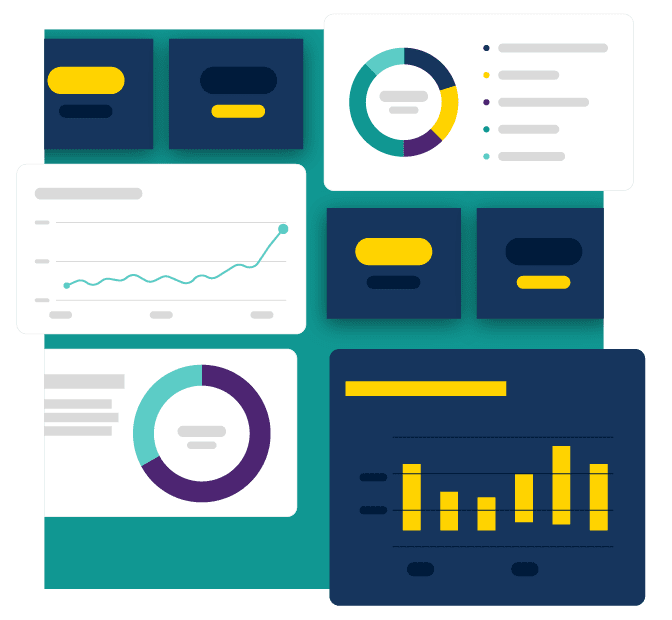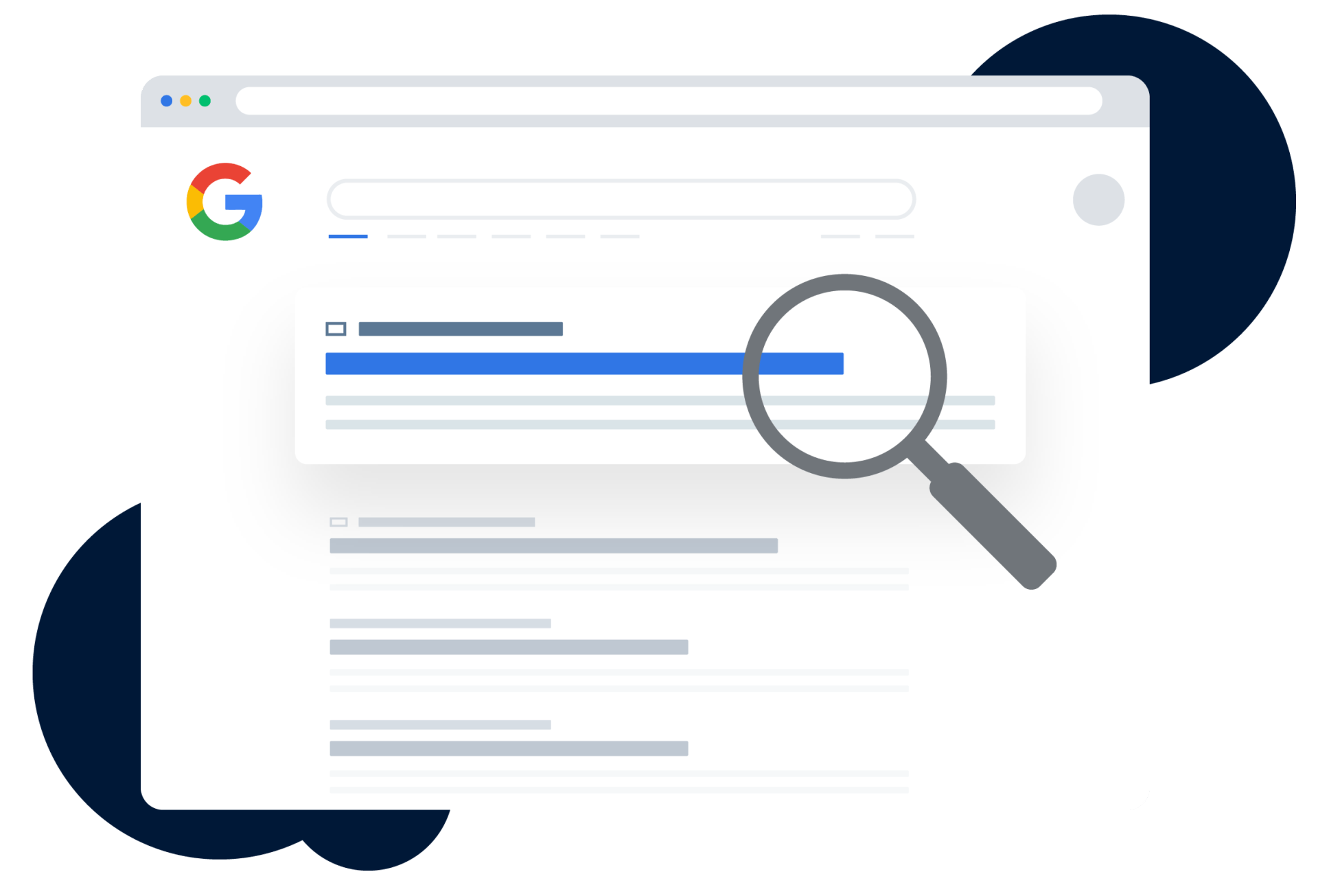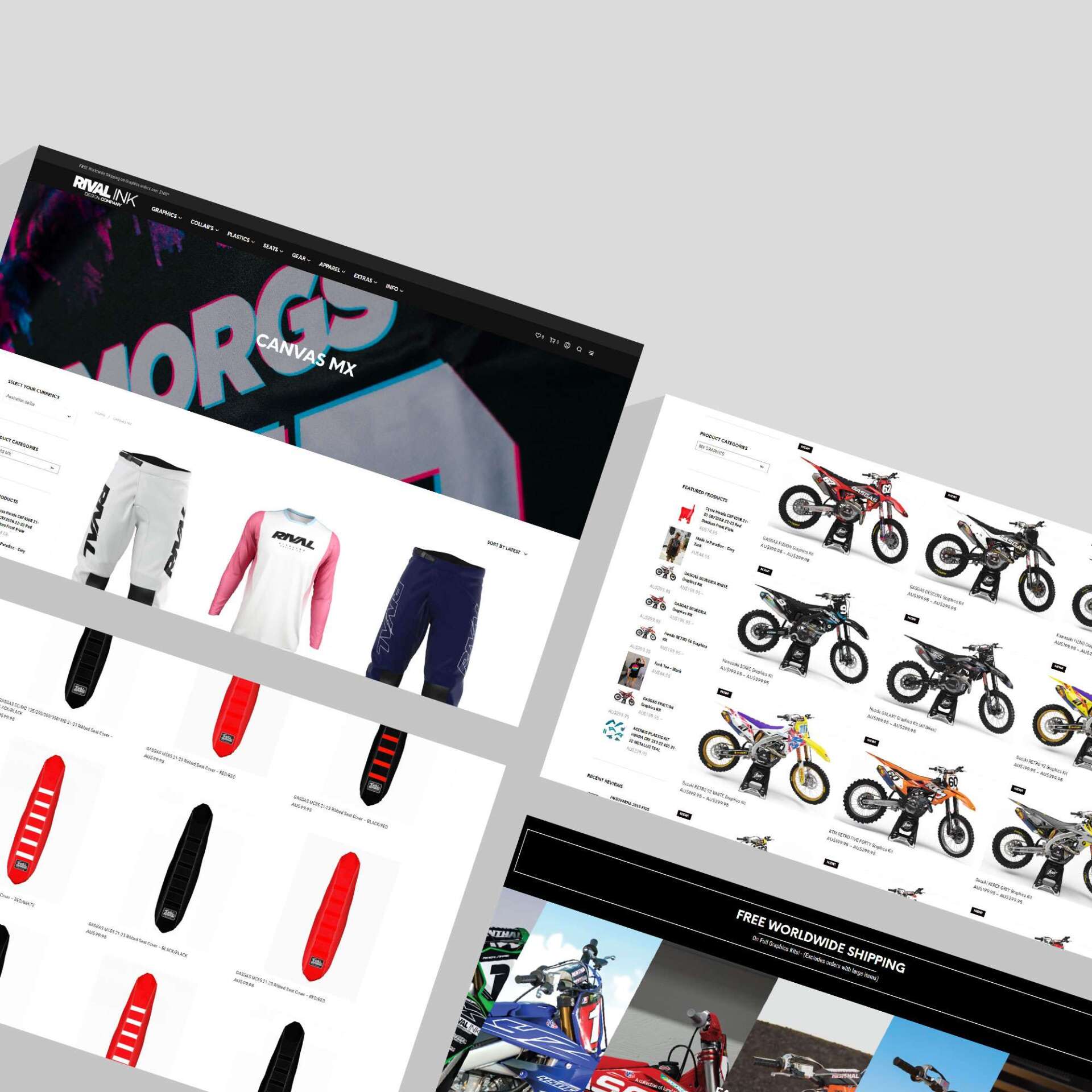Boost Your Sales: Understanding Australian Ecommerce Conversion Rates
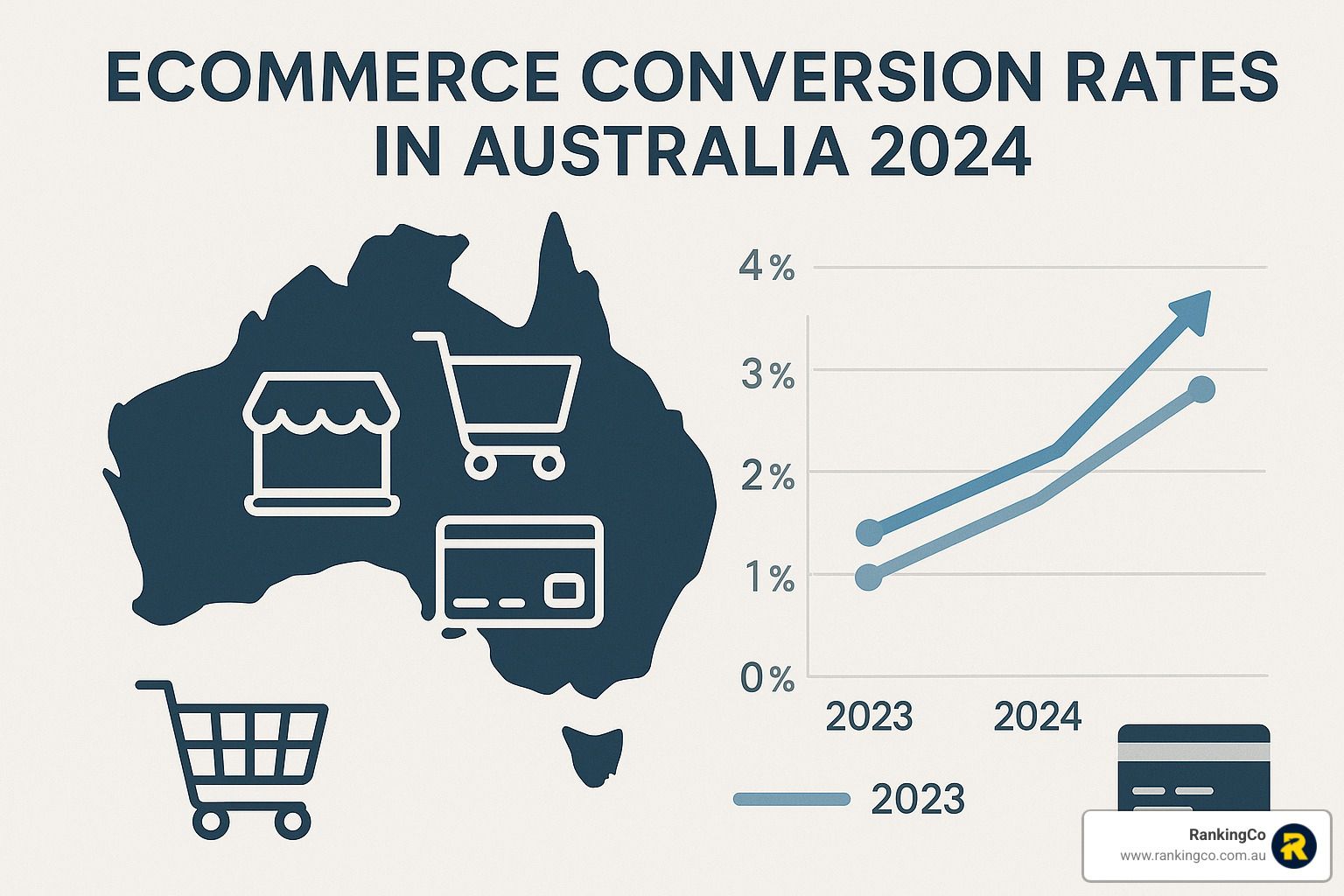
The State of Australian Ecommerce Conversion in 2024
Ecommerce conversion rates Australia average approximately 1.78% as of September 2024, slightly below the global average of 1.88%.
The digital marketplace in Australia continues to evolve rapidly, with online retail now constituting 16.8% of total retail spending.
Despite economic challenges, the Australian ecommerce sector generated AU$56.07 billion in revenue in 2024, with 17.08 million monthly active users representing a 63.94% market penetration.
What makes these numbers particularly interesting is how they vary across industries. While luxury brands might struggle with conversion rates around 1.46%, food and beverage retailers enjoy rates as high as 6.26%. Arts and crafts stores also perform exceptionally well at 5.2%.
Behind these numbers lies a complex web of factors affecting how Australian shoppers decide to click "buy now" – from payment preferences to mobile usability, trust signals to delivery options.
I'm Amber Porter, CEO of RankingCo, and I've helped dozens of Australian businesses improve their ecommerce conversion rates Australia through data-driven optimization strategies and custom digital marketing approaches. My team and I specialize in turning website visitors into paying customers through proven conversion techniques.
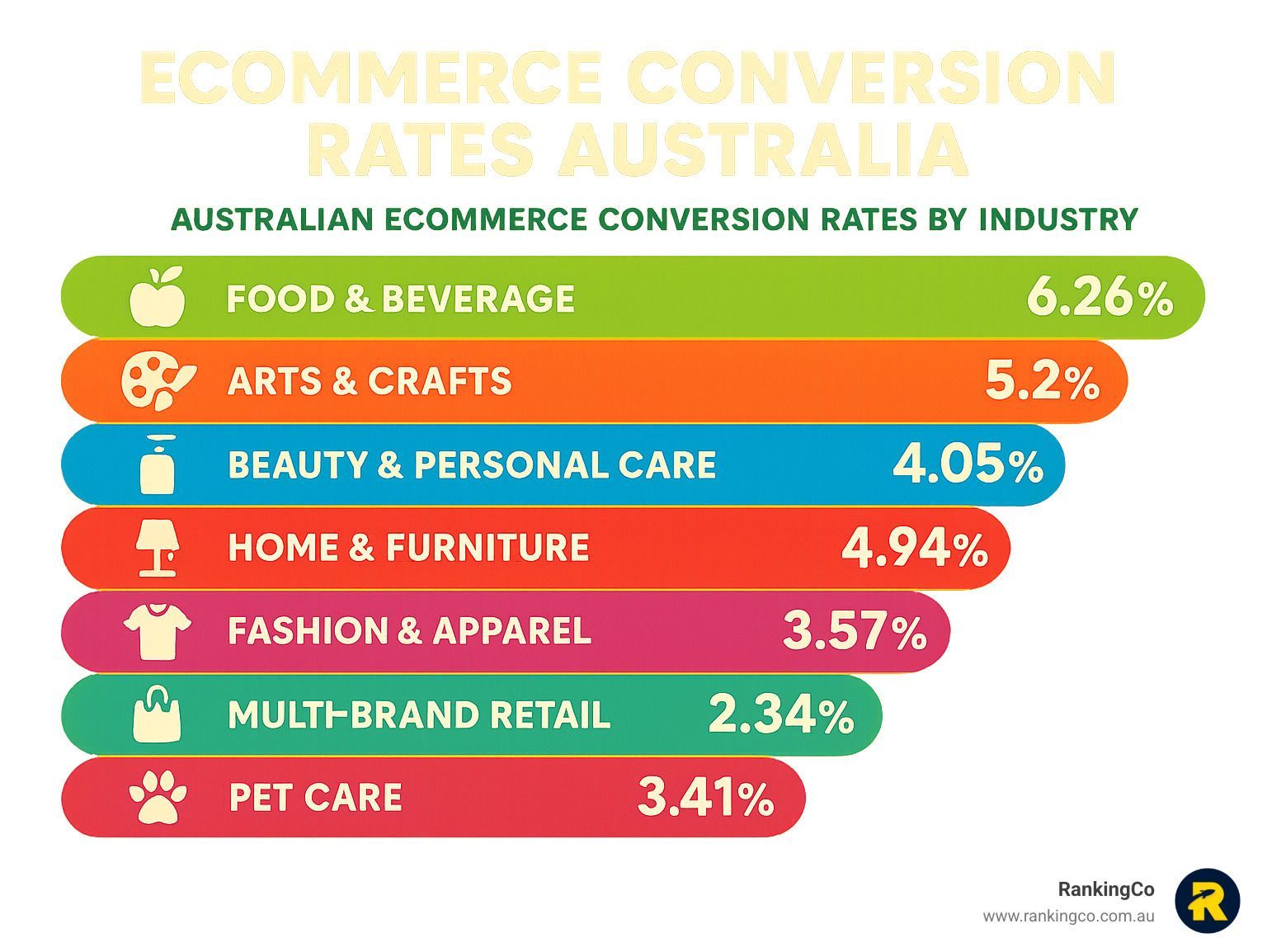
Decoding Ecommerce Conversion Rate & Funnel Metrics
Let's take a moment to understand what we're actually talking about when we say "conversion rate" – because knowing what you're measuring is the first step to improving it!
An ecommerce conversion rate is simply the percentage of your website visitors who follow through with a purchase. The formula isn't complicated:
Conversion Rate = (Number of Conversions ÷ Number of Total Visits) × 100
So if your online store welcomes 5,000 visitors in a month and 100 of them decide to buy something, your conversion rate sits at 2%. Not rocket science, but incredibly powerful when you understand what it's telling you.
Here's something important though – we calculate based on sessions (visits), not unique users. Why? Because real shopping behaviour isn't linear. Someone might browse your products on Monday, compare prices on Tuesday, and finally make that purchase on Wednesday. Each of those visits represents a fresh opportunity to convert.
You'll also want to differentiate between macro conversions (the big wins – completed purchases) and micro conversions (smaller victories like email sign-ups, wishlist additions, or add-to-cart actions). While the ultimate goal for any online store is certainly sales, those micro moments give you valuable insights into where your funnel might be leaking potential customers.
Key Calculation Steps
Getting accurate ecommerce conversion rates Australia businesses can trust isn't complicated, but it does require attention to detail:
- Track your total visitors using tools like Google Analytics 4. Make sure your tracking is properly configured to capture all traffic sources – a missing pixel here or there can skew your entire dataset.
- Monitor your conversions during that same period. In GA4, you'll typically find this in the "Conversions" report under "Ecommerce purchases." For a detailed explanation of how this works, Analytics Mania provides an excellent guide.
- Do the maths using our formula above. Most analytics platforms handle this automatically, but understanding how the calculation works helps you interpret what the numbers are actually telling you.
The real magic happens when you segment your data. Breaking down your conversion rate by traffic source, device type, product category, and customer type (new vs returning) reveals patterns that a single overall percentage simply can't show. For example, we often find that returning customers convert at 2-3 times the rate of first-time visitors for our eCommerce SEO clients.
As for timing, we recommend weekly reviews for tactical tweaks (like adjusting ad spend or fixing a problematic page) and monthly reviews for broader strategic decisions. If your business has seasonal patterns, year-over-year comparisons will typically give you more meaningful insights than month-to-month fluctuations.
Conversion rate isn't just a vanity metric – it's a direct reflection of how well your website connects with your audience's needs. At RankingCo, we've seen first-hand how small improvements in conversion rates can transform an online store's profitability without requiring any additional traffic.
Ecommerce Conversion Rates Australia 2024 Benchmarks
Let's talk about how your store stacks up against the competition. When comparing your performance to ecommerce conversion rates Australia benchmarks, context is absolutely everything. While the national average sits at 1.78%, most industry experts suggest aiming higher—somewhere between 2.5% to 3% for Australian online stores.
Looking to the future, there's good news on the horizon. We're forecasting Australian conversion rates to climb to between 2% and 4% in 2025. This growth isn't just wishful thinking—it's being driven by real improvements in user experience, expanded payment options, and the increasing sophistication of personalisation technology.
Some sectors are already outperforming the pack. The service industry is leading the charge with an impressive 3.3% average conversion rate. And if you're in B2B? You might be looking at rates as high as 12.3%, which makes sense when you consider the relationship-driven nature of business purchases and the higher intent of B2B buyers.
For the Shopify crowd (and we work with many of you!), the average conversion rate hovers around 1.4%. But don't let that number discourage you—top performers in the Australian Shopify ecosystem (the top 20%) are achieving 3.2% or better, while the elite 10% are smashing it with rates of 4.7% or higher. According to Littledata's survey of Shopify stores, these top performers are consistently implementing optimisation strategies that set them apart from the competition.
Geography plays a fascinating role too. Western Australia is currently leading the nation in ecommerce spending growth at 5.1% year-over-year, with the Northern Territory close behind at 4.6%. This regional variation suggests conversion rates likely differ across Australian states and territories, offering opportunities for geographically-targeted optimisation.
Industry & Site-Type Snapshot
The reality is that ecommerce conversion rates Australia vary dramatically depending on what you're selling:
Food & Beverage stores are the conversion champions at 6.26%, while Arts & Crafts retailers aren't far behind at 5.2%. Home & Furniture sites convert at a healthy 4.94%, with Beauty & Personal Care products turning browsers into buyers at a rate of 4.05%.
Fashion retailers average 3.57%, while Pet Care businesses convert at 3.41%. Multi-Brand Retail sits at 2.34%, and Luxury & Jewelry brands typically see the lowest rates at 1.46%—a reminder that higher price points often mean longer consideration periods.
Different types of websites also show distinct conversion patterns. Traditional ecommerce sites typically convert between 1% and 5%, depending on product type and price point. Lead generation sites perform much better, ranging from 5% to 20%, with dedicated landing pages often achieving between 8.8% and 18.2%. Affiliate websites typically convert between 1% and 3%, while blog websites focusing on email sign-ups can exceed 5% when content truly resonates with visitors.
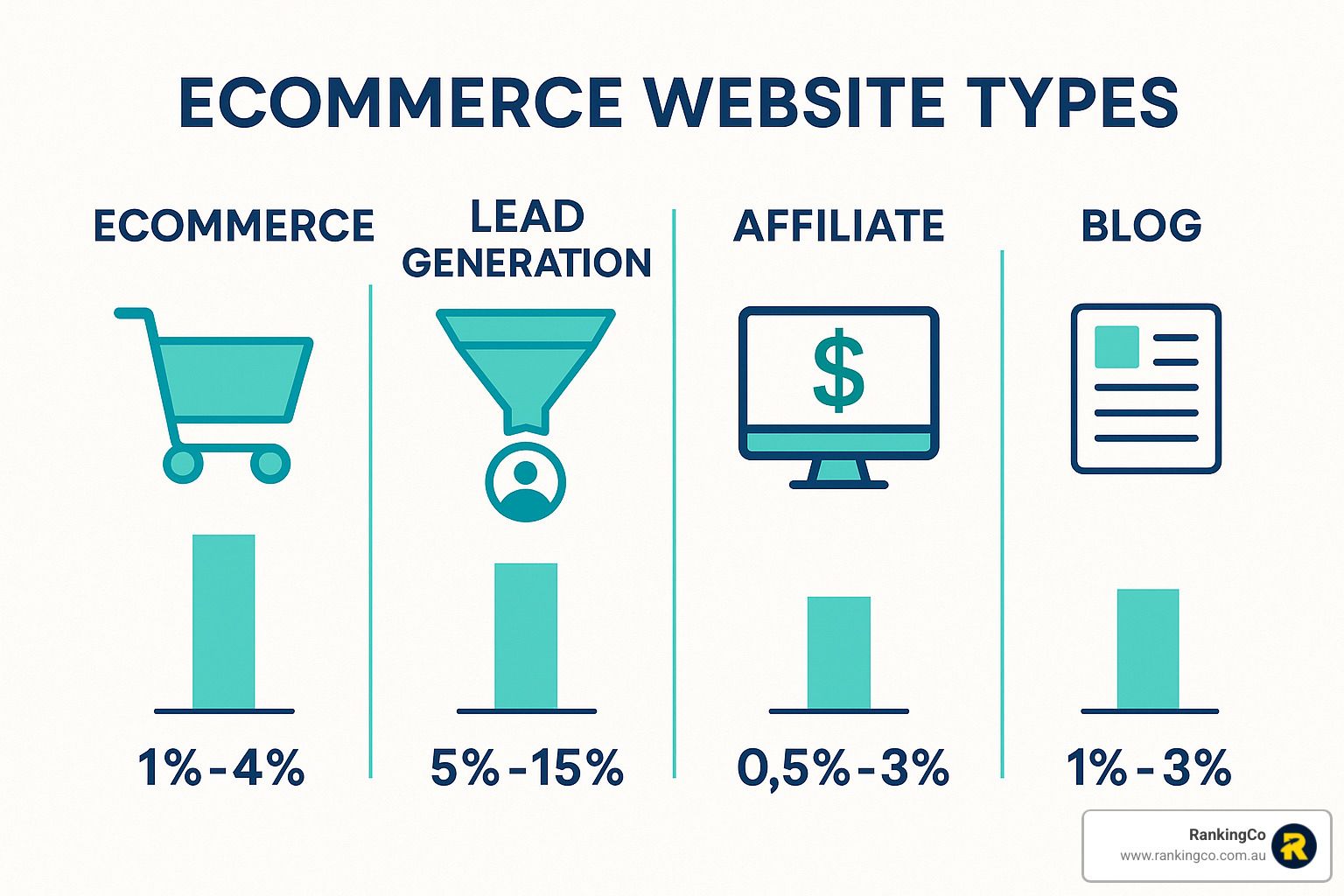
Add-to-Cart & Abandonment Pulse
Understanding the full conversion funnel gives us a clearer picture of where potential sales slip away. In 2024, the add-to-cart rate for Australian online stores sits at 9.1%, but—and here's the painful bit—the cart abandonment rate is a whopping 62.6%.
Think about that for a moment: about 9 out of every 100 visitors add products to their cart, but nearly 63% of those potential customers leave without completing their purchase. That's a lot of almost-sales! The good news? This creates a significant opportunity for recovery strategies like abandoned cart emails and retargeting campaigns.
One eye-opening finding from recent Australian retail research is that checkout processes taking longer than 90 seconds lead to a 47% decline in conversions. Australian shoppers value their time—speed and simplicity at checkout aren't just nice-to-haves, they're essential for maximising your conversion potential.
If you're looking to improve your checkout process and boost those conversion numbers, our eCommerce SEO services can help identify and fix the friction points that might be causing potential customers to abandon their carts.
Traffic Source, Device & Regional Variations in Australian CVR
When it comes to ecommerce conversion rates Australia, not all traffic is created equal. In fact, where your visitors come from dramatically impacts their likelihood to purchase. Let's look at the fascinating patterns we're seeing across the Australian market in 2024:
Email marketing continues to deliver impressive results with conversion rates between 2% and 5%, proving that your existing customer base remains your most valuable asset. Referral traffic (5.44%) shows the power of word-of-mouth in the Australian market, while paid search through Google Ads converts at a healthy 4.8%.
Perhaps most surprising is Facebook's stellar performance, with a conversion rate of 9.21% – significantly outperforming other social platforms like Instagram (1%) and Pinterest (1.16%). This highlights the maturity of Facebook as a shopping destination for Australians.
Organic search traffic typically converts between 2% and 3%, while direct traffic sits around 3.5% – both solid foundations for sustainable growth.
The device your customers use also tells an important story. Despite mobile devices accounting for 73% of ecommerce traffic in Australia, they convert at just 2.9% – significantly lower than desktop's impressive 4.8%. Tablets fall somewhere in between at 3%.
This mobile-desktop gap represents one of the biggest opportunities for Australian retailers. While Aussies love browsing on their phones, something is clearly holding them back from completing purchases on these devices – whether it's trust concerns, complicated checkout processes, or simply poor mobile experiences.
Regional variations across Australia add another layer to this story. Western Australia leads the pack with 5.1% year-over-year growth in online spending, followed closely by Northern Territory (4.6%) and Queensland (4.2%). This outpaces the eastern states, with Victoria (3.8%), New South Wales (3.5%), and South Australia (3.2%) showing more modest growth. Tasmania (3.0%) and ACT (2.8%) round out the list.
These regional differences reflect varying levels of ecommerce adoption, competitive landscapes, and economic factors that savvy marketers can leverage in their targeting strategies.
What This Means for Budget Allocation
These insights should directly shape where you invest your marketing dollars. For most Australian ecommerce businesses, we recommend:
Prioritise your high-converting channels first. Email and referral traffic typically deliver the best bang for your buck, followed by direct traffic and paid search. These channels often represent customers further along in their buying journey.
Optimise your Google Ads campaigns to capture high-intent traffic. With a 4.8% average conversion rate, paid search remains one of the most effective channels for Australian ecommerce. Our Google Ads Management services can help you maximise performance in this crucial channel.
Don't ignore the Facebook opportunity. That 9.21% conversion rate is simply too good to overlook. While other social platforms may require awareness-focused strategies, Facebook has matured into a genuine conversion powerhouse for Australian retailers.
Implement smart retargeting strategies. With cart abandonment rates at 62.6%, thoughtful retargeting campaigns can recapture significant lost revenue. This is especially effective when combined with email marketing.
Invest seriously in mobile optimisation. The gap between mobile traffic (73%) and conversion rate (2.9%) represents the single biggest opportunity for most Australian retailers. Our eCommerce SEO approach places special emphasis on mobile experience to help close this gap.
By aligning your budget with these channel-specific insights, you'll be well-positioned to exceed the average ecommerce conversion rates Australia benchmarks and drive sustainable growth for your online store.
Why Aussies Convert (or Don't): Factors & Emerging Trends
Ever wondered what makes Australian shoppers hit that "buy now" button—or abandon their carts altogether? The psychology behind ecommerce conversion rates Australia reveals fascinating insights into our shopping habits.
Trust sits at the heart of online purchasing decisions. A whopping 20% of Aussie consumers simply won't complete a purchase without seeing security badges at checkout. It's not just about having SSL certificates—though those are essential—it's about visibly demonstrating your site is safe. We've noticed a growing preference for homegrown brands too, with many shoppers choosing local businesses they feel they can trust.
When it comes to payment options, Australians have clear preferences. Nearly half (46%) expect traditional debit and credit card options, while 27% look for digital wallet solutions like Apple Pay or PayPal. The buy now, pay later revolution continues to gain traction, with 21% of shoppers expecting services like Afterpay or Zip. Cryptocurrency remains a niche preference at just 6%, but this figure is steadily climbing.
Shipping policy can make or break your conversion rate. Free shipping remains the champion conversion driver, with 66.5% of users citing it as a key factor in their decision to purchase. Beyond cost, Australians value transparency about delivery timeframes, and increasingly, they're considering the environmental impact of their deliveries. Our eCommerce SEO specialists have seen significant improvements in conversion rates when shipping information is clearly displayed early in the shopping journey.
The mobile experience continues to be a critical factor—and often a conversion killer. One in four Aussie shoppers expect lightning-fast loading times, and research shows that checkout processes exceeding 90 seconds lead to a staggering 47% drop in conversions. That's nearly half your potential sales walking away because your mobile checkout is too cumbersome!
Product presentation matters enormously. Videos are particularly powerful, with 73% of consumers more likely to purchase after watching a product demonstration. Multiple high-quality images showing different angles boost confidence, while detailed yet scannable product descriptions that focus on benefits rather than features help shoppers make decisions faster.
The power of social proof can't be overstated. A remarkable 95% of customers read reviews before purchasing, and over 80% trust these online reviews as much as personal recommendations from friends or family. User-generated content like customer photos or videos can yield up to six times higher conversion rates compared to professional content alone.
2025 Trend Watch
Looking ahead, several emerging trends are set to reshape ecommerce conversion rates Australia in the coming year.
Mobile checkout will continue to evolve, with streamlined payment processes helping to close the significant gap between mobile traffic and actual conversions. Social commerce integration is booming, projected to reach $2.9 trillion globally by 2026, as purchasing flows become embedded directly within social platforms.
AI-driven personalisation is proving to be a game-changer, with intelligent product recommendations boosting conversion rates by up to 30%. It's no wonder that 49% of marketers are now leveraging AI to create personalised content that resonates with specific audience segments.
Voice commerce is gaining momentum as more Australians adopt smart speakers and voice assistants. Sustainability has moved from a nice-to-have to a must-have, with environmental considerations increasingly factoring into purchase decisions for eco-conscious Aussie shoppers.
Perhaps most exciting is the rise of augmented reality shopping experiences. Early adopters of AR/VR technology have seen up to 20% higher conversion rates and 30% increased customer satisfaction. Imagine letting customers virtually "try before they buy"—whether it's seeing how furniture fits in their home or how clothing looks on their body.
According to recent BCG research, these emerging technologies are not just novelties but are becoming essential tools for retailers looking to stay competitive in the Australian market.
At RankingCo, we're helping Brisbane businesses stay ahead of these trends with our data-driven Digital Marketing Services in Brisbane that focus on conversion optimisation strategies custom to the unique preferences of Australian consumers.
9 Proven Strategies to Lift Your Australian Ecommerce Conversion Rate
Let's face it—turning browsers into buyers is both an art and a science. After helping dozens of Australian online stores boost their numbers, I've seen what moves the needle on ecommerce conversion rates Australia. These nine strategies consistently deliver results for our clients, regardless of their industry or size.
1. Develop a Clear Value Proposition
Australian shoppers are savvy and time-poor. They need to understand within seconds why they should choose you over competitors. Your unique selling proposition should jump off the page on your homepage and product listings.
Ask yourself: "If a visitor gives me just five seconds of attention, will they understand why my store deserves their business?" Whether it's your sustainable practices, lightning-fast shipping, or exclusive product range—make it unmissable.
2. Optimize Site Speed and Performance
Nothing kills conversions faster than a sluggish website. Our research consistently shows that each second of delay in page loading reduces conversions by around 7%. That's a massive hit to your bottom line.
Make sure your hosting can handle traffic spikes, compress those beautiful product images, and ruthlessly eliminate unnecessary scripts. If technical optimisation feels overwhelming, our Technical SEO team can identify and fix the performance bottlenecks holding you back.
3. Implement Mobile-First Design
Here's a striking disconnect: 73% of ecommerce traffic in Australia comes from mobile devices, yet they convert at only 2.9% compared to desktop's 4.8%. That gap represents an enormous opportunity.
Your mobile experience should feel seamless and natural—with touch-friendly navigation, simplified forms that don't frustrate thumbs, and large, easy-to-tap buttons. Product images should load quickly, and your checkout process should feel effortless, not like an obstacle course.
4. Simplify the Checkout Process
Australian research reveals a sobering statistic: checkout processes longer than 90 seconds cause a 47% drop in conversions. Nearly half your potential sales, gone because of a clunky checkout!
Streamline your path to purchase by reducing form fields to only what's absolutely necessary. Add a progress indicator so customers know how close they are to finishing. Enable address autofill, eliminate distractions, and please—don't force account creation or surprise people with unexpected fees at the last moment.
5. Offer Multiple Payment Options
Australians have clear payment preferences: 46% expect card options, 27% want digital wallets, and 21% look for BNPL services. Meeting these expectations isn't just nice—it's necessary.
At minimum, your store should offer credit/debit cards, PayPal, Apple Pay/Google Pay, and at least one buy-now-pay-later option like Afterpay. Each missing payment method potentially costs you customers who simply won't complete their purchase without their preferred option.
6. Use Compelling Content and Social Proof
Product pages that convert are rich with persuasive elements. High-quality images showing products from multiple angles are essential, but product videos can boost conversions by up to 73%—they're worth the investment.
Your descriptions should be detailed but scannable, highlighting benefits over features. And don't underestimate social proof: customer reviews, ratings, and user-generated content create confidence and reduce purchase anxiety. When someone sees others enjoying your products, they can more easily imagine themselves doing the same.
7. Implement Personalisation
The days of one-size-fits-all shopping experiences are behind us. Personalised experiences can lift conversion rates by 15-20% by making customers feel understood and valued.
Consider product recommendations based on browsing history, "recently viewed" sections, personalised email marketing, and customer-specific promotions. Our eCommerce SEO services include personalisation strategies that work hand-in-hand with search optimisation to create experiences that feel tailor-made.
8. Deploy Strategic Remarketing
With cart abandonment rates hovering at 62.6% in Australia, remarketing isn't optional—it's essential for recapturing lost sales.
Implement abandoned cart email sequences that gently remind shoppers about items they've left behind. Use display remarketing to stay top-of-mind as they browse elsewhere. Consider offering incentives for cart completion, like free shipping or a small discount. And remember to segment your remarketing based on product category and cart value for maximum relevance.
9. Continuously Test and Optimize
Conversion optimisation isn't a set-and-forget task—it's an ongoing process of improvement. A/B testing should become a habit, not a one-off project.
Test one element at a time (headlines, images, CTAs) to clearly understand what drives improvements. Ensure your tests run long enough to achieve statistical significance. Segment your results by traffic source and device to uncover deeper insights. And most importantly, document your findings so you can apply those learnings across your site.
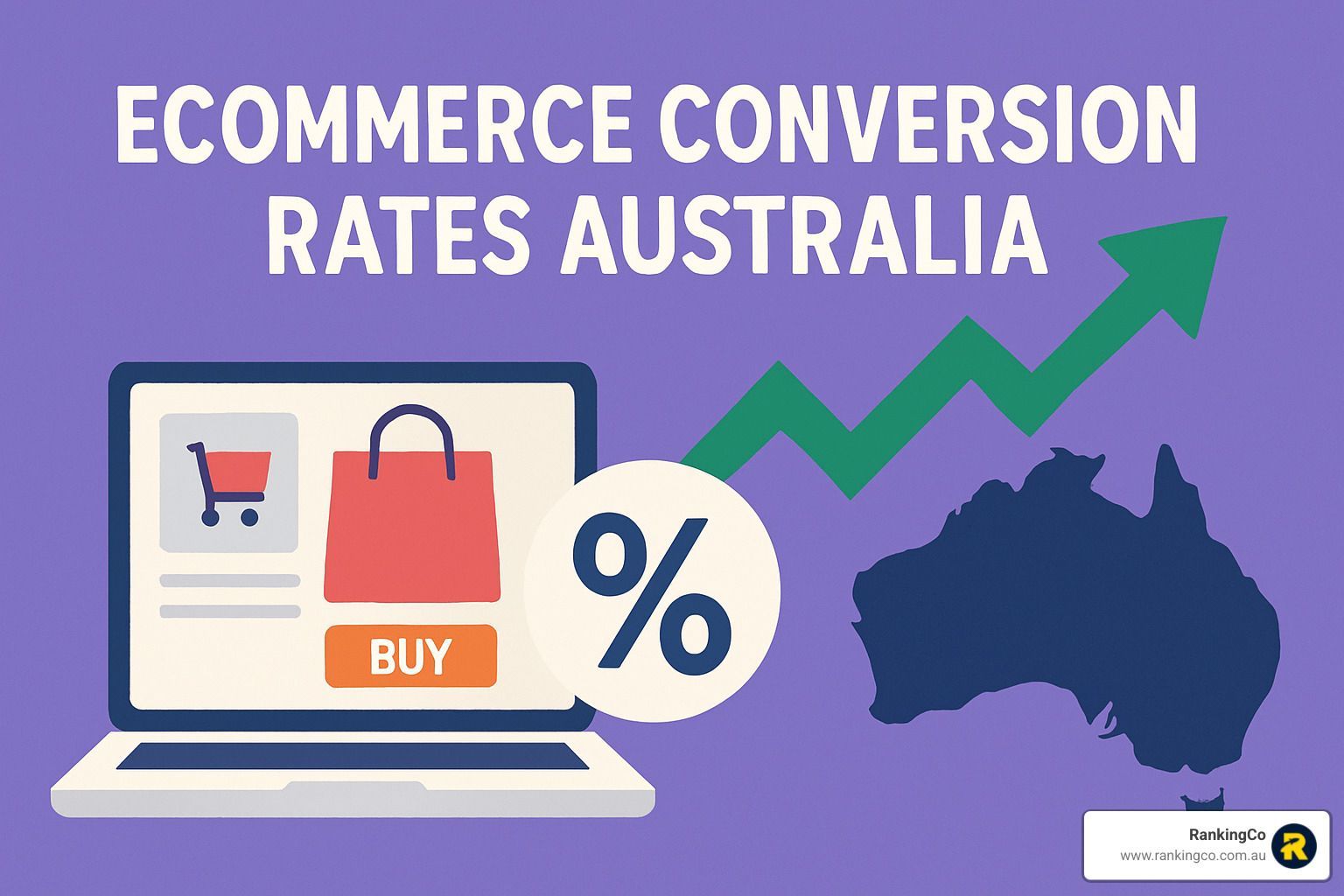
Recommended Tools & Services
To put these strategies into action, you'll need the right toolkit. We regularly recommend:
Analytics tools like Google Analytics 4, Segment, and Triple Whale to understand visitor behaviour. Heatmapping and session recording from Hotjar or Lucky Orange to see exactly how users interact with your site. A/B testing platforms such as Google Optimize or VWO to systematically improve elements. Personalisation engines like Dynamic Yield or Nosto to create custom experiences. And remarketing tools including Google Ads, Facebook Ads, and Klaviyo for email sequences.
Need help implementing these strategies? Our Digital Marketing Services in Brisbane team specialises in conversion optimisation custom specifically for Australian ecommerce businesses. We understand the local market and what makes Aussie shoppers tick.
Frequently Asked Questions about Ecommerce Conversion Rates Australia
What is a "good" ecommerce conversion rate in Australia?
I'm often asked this question by clients who are eager to benchmark their performance. While the average ecommerce conversion rates Australia sits at 1.78%, what's "good" really depends on your specific situation.
For most online stores, hitting 2.5-3% puts you in a healthy position. If you're reaching 3-5%, you're outperforming many of your competitors. And those lucky businesses achieving 5% or higher? They're typically in high-converting niches like food & beverage (where we see impressive 6.26% averages) or arts & crafts (around 5.2%).
Rather than obsessing over industry benchmarks, I always recommend focusing on your own trajectory. Even a seemingly modest 0.5% improvement in your conversion rate can dramatically boost your revenue. Conversion optimisation is a marathon, not a sprint!
How often should I review and optimise my CVR?
Finding the right rhythm for conversion analysis is crucial. In my experience working with Australian ecommerce businesses, a layered approach works best:
Weekly check-ins help you spot any sudden drops that might signal technical problems or market shifts. Think of these as your quick health checks.
Monthly deep dives give you the chance to analyse performance across different traffic sources, devices, and product categories. This is where patterns start to emerge.
Quarterly strategy sessions are perfect for comprehensive reviews and implementing major changes based on accumulated data.
And don't forget campaign-specific analysis during and after marketing pushes – these provide valuable insights into what resonates with your audience.
This balanced approach ensures you're responsive to immediate issues while still gathering enough data for meaningful optimisations. It's the sweet spot between reactivity and strategic thinking.
Which payment options most influence Australian shoppers?
Payment choices can make or break your conversion rates in the Australian market. Our research shows some clear preferences:
Credit and debit cards remain the backbone of online payments, with 46% of Aussie shoppers expecting these options. They're familiar, trusted, and not going anywhere.
Digital wallets like PayPal, Apple Pay and Shop Pay are gaining serious traction, with 27% of customers now expecting these convenient options at checkout.
The buy now, pay later revolution continues to grow, with 21% of shoppers looking for services like Afterpay and Zip. These options can boost your average order value by up to 30% – particularly appealing for higher-priced items.
Cryptocurrency payments remain a niche preference, with only 6% of customers currently expecting this option. Worth considering if you're in a tech-forward market, but not essential for most businesses.
The data is clear: offering streamlined, diverse payment methods can increase conversion rates by up to 50%. If you're looking for a high-impact optimisation area, payment options should be near the top of your list.
For more insights on creating high-converting digital experiences, check out our guide to Conversion Rate Optimization Melbourne or speak with our Ecommerce SEO Consultant team for custom advice.
Open up Your Potential – Get Ranking with RankingCo
The journey to optimising ecommerce conversion rates Australia isn't a quick fix—it's about crafting an experience that genuinely connects with Australian shoppers. And the data we've explored throughout this article paints a clear picture of what that means.
Australian online shoppers have spoken through their clicking (or non-clicking) habits. They crave seamless mobile experiences, multiple payment options, crystal-clear shipping policies, and product information that answers their questions before they even ask.
Meeting these expectations isn't just good practice—it's the difference between a 1.78% conversion rate and the 3-5% that top performers achieve.
At RankingCo, we've seen how seemingly small optimisations can transform an ecommerce business. One of our Brisbane clients increased their conversion rate by 37% simply by restructuring their checkout process and adding trust signals at critical decision points. Another saw mobile conversions double after we implemented a responsive redesign focused on thumb-friendly navigation.
These aren't isolated successes. They're the result of our data-driven approach to understanding exactly what makes Australian shoppers click "buy now."
Our Brisbane team brings a uniquely local perspective to ecommerce optimisation. We understand the nuances of the Australian market—from regional shopping preferences to seasonal trends that affect buying behaviour across different product categories. This local knowledge, combined with our technical expertise in eCommerce SEO and Google Ads Management, creates a powerful formula for conversion growth.
Whether you're battling high cart abandonment rates, struggling to convert mobile visitors, or simply looking to squeeze more revenue from your existing traffic, we've been there and solved that. Our approach isn't about applying generic "best practices"—it's about finding the specific optimisations that will move the needle for your unique business.
Ready to turn more browsers into buyers? Let's have a conversation about your ecommerce conversion rates Australia and develop a strategy that transforms your digital performance. With RankingCo as your partner, you'll not only understand your conversion data better—you'll know exactly how to improve it.
The path to higher conversions starts with a single step. Take it today.
